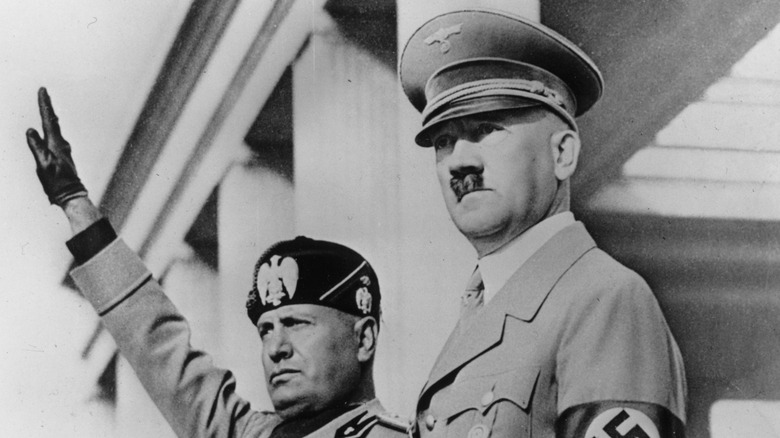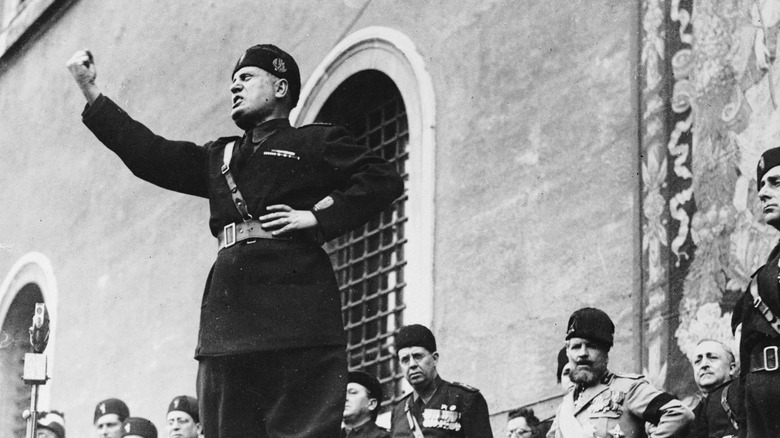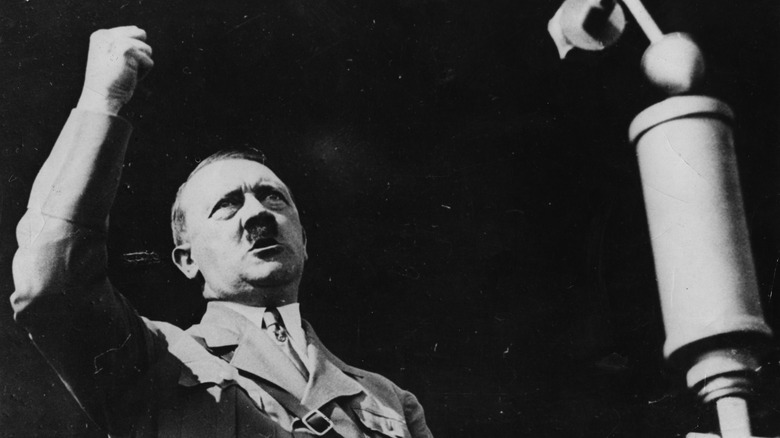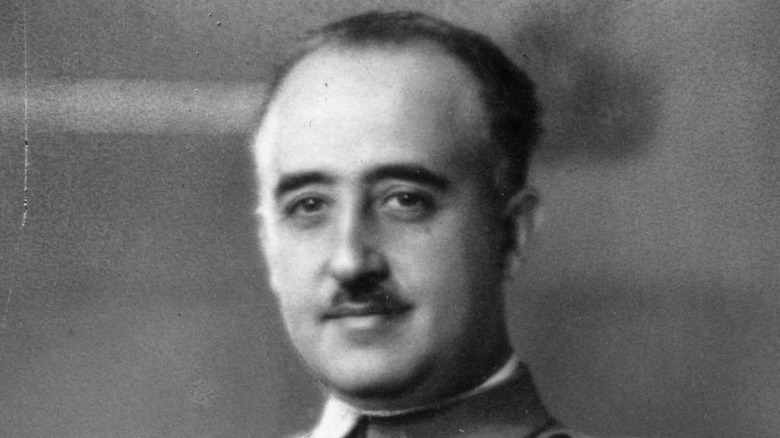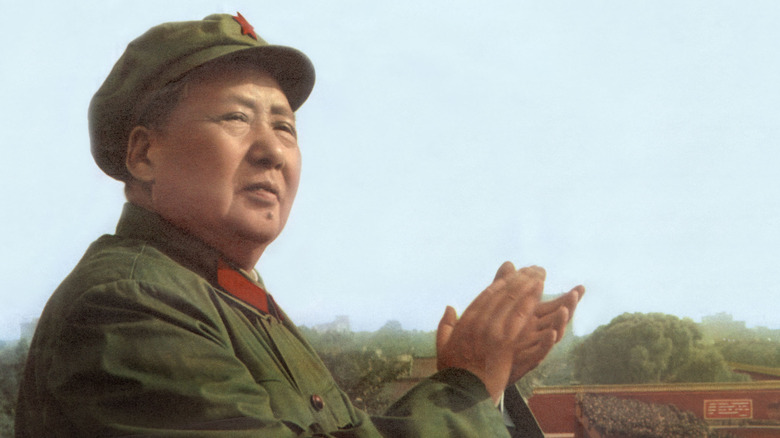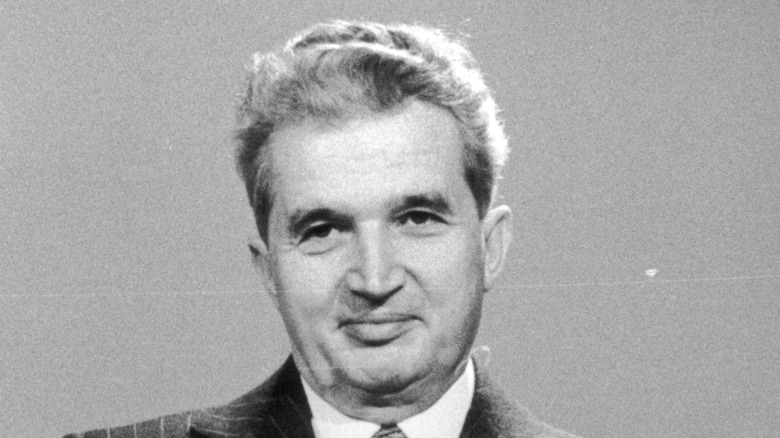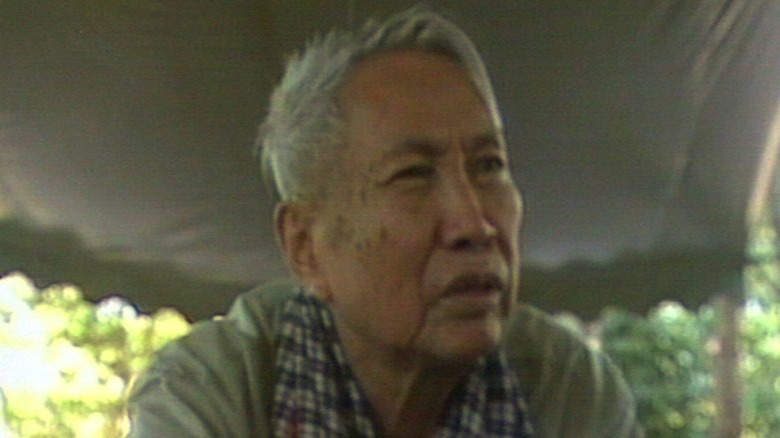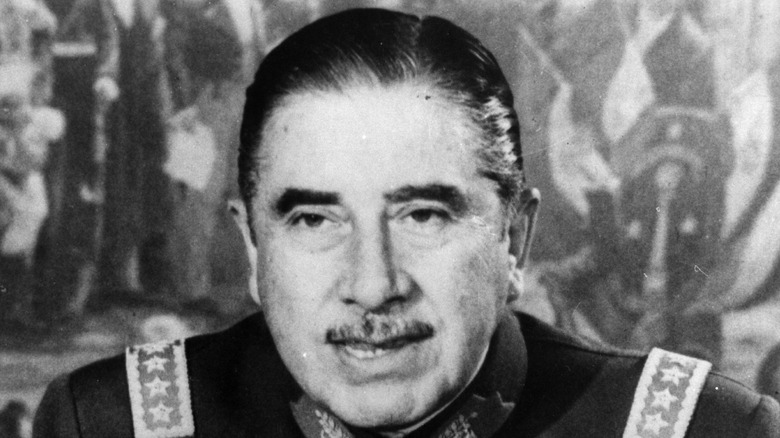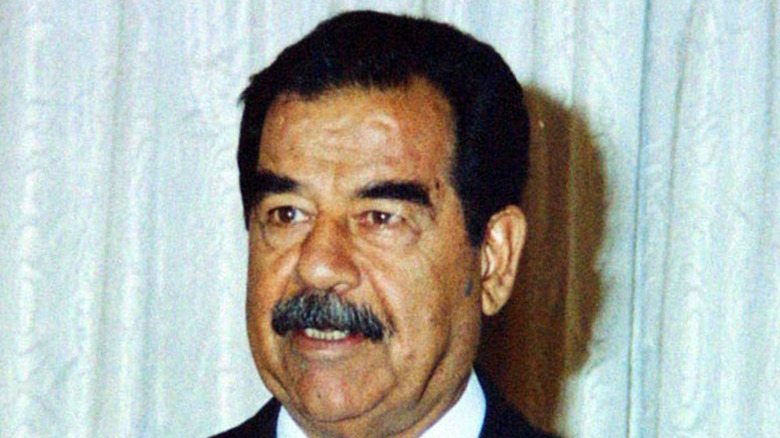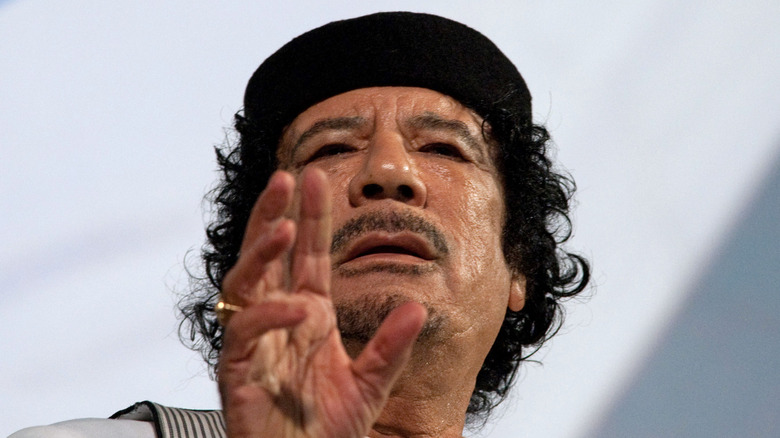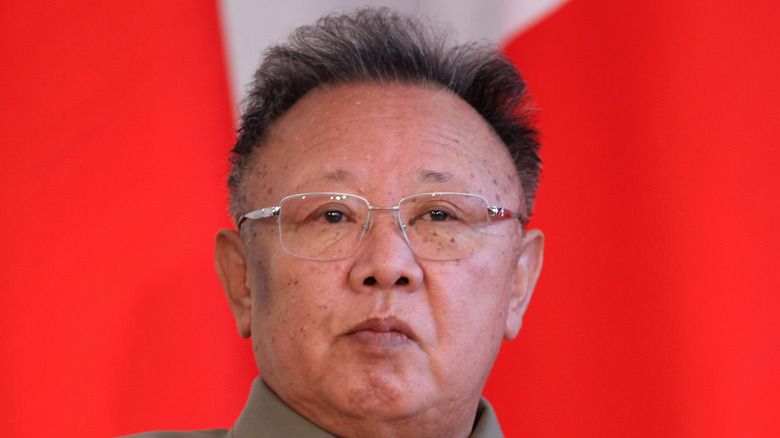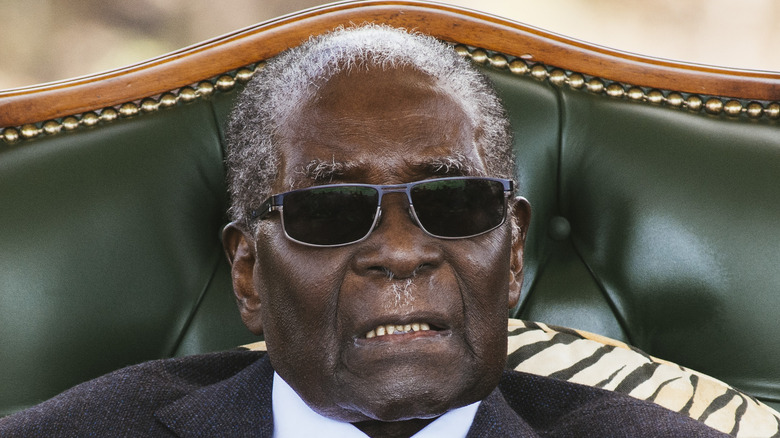Here's What Happened To The Bodies Of These Dictators
It's often a historic event when an infamous dictator dies. After years of total and often violent control over a populace, the deaths of such figures leave their fervent supporters mourning and those who've suffered under their rule relieved or even celebratory. Some dictators have died at the hands of those they oppressed and others have simply passed away of old age or disease. But, even after they've passed, the bodies of these brutal leaders often remain a topic of interest.
As people who committed unforgettable and ruthless acts, many dictators have become a target of worship or hate even after death. In some occasions, zealous followers have flocked to their graves, reinforcing the dictator's power and legend. Other dictators have had their tombs or bodies publicly defiled and vandalized. From being embalmed for eternal display to being stolen from their graves, here's what happened to the bodies of some of the most notorious dictators.
Benito Mussolini's corpse was publicly desecrated in Milan
As described by History, Italian dictator Benito Mussolini was forced to flee his country as Allied forces started making their way up the Italian peninsula. He tried to escape to Switzerland with his mistress, Clara Petacci, and a few German guards on April 25, 1945. Despite dressing up in German attire, years of propaganda made the infamous "Il Duce" immediately recognizable. According to the National WWII Museum, two days into their journey, Mussolini and Petacci were captured by partisans and, on April 28, 1945, were executed by firing squad.
The dictator and his paramour's corpses were taken to Milan, where they were hung up by the heels, dangling upside down in front of a gas station at the Piazzale Loreto. Crowds gathered to curse, spit, kick, and defile the bodies, with a woman reported to have stepped forward and pumped "five bullets into [Mussolini's] body," saying "for my five dead sons."
Once the corpse of the Italian dictator was thoroughly defiled by the public, Mussolini's body was buried in an unmarked grave. According to NPR, just a year later, it was dug up by neo-Fascists and stolen. The Italian government was quickly able to arrest the thieves and recover the body, which they then hid in a monastery near Milan for over a decade. It wasn't until 1957 that Mussolini's wife succeeded in moving his body to the family mausoleum in Predappio. The tomb receives 100,000 visitors a year.
Adolf Hitler wished to avoid the end that Mussolini experienced
Knowing that his dictatorship was ending, Nazi leader Adolf Hitler committed suicide along with his new wife Eva Braun on April 30, 1945, according to ThoughtCo. Not wanting his body to be "strung up or mutilated like Benito Mussolini's," the dictator ordered for their bodies to be burned after their deaths, as explained by Smithsonian.
The bodies of Hitler and Braun were subsequently burned, and their charred remains were discovered by Russian troops just a few days later on May 5, 1945. After taking a few photographs of the remains, the Russians reportedly "reburied them twice in secret locations," where they remained for 25 years. In 1975, the head of the KGB ordered for Hitler and Braun to be dug up "to prevent the burial site from becoming a pilgrimage for fascists." The corpses were burned to ash and dumped into the Biederitz River, but the Soviets kept some pieces of Hitler: a part of his jaw and a portion of his skull with a bullet wound.
While some claim that the skull is actually a woman's (despite Russia denying ever giving access to those claimants), the teeth have been identified as Hitler's, and both remains are in the Russian State Archive to this day.
If you or anyone you know is having suicidal thoughts, please call the National Suicide Prevention Lifeline at 1-800-273-TALK (8255).
Joseph Stalin's body was originally displayed by Vladimir Lenin's
Though he is now widely considered to be a dictator responsible for "the deaths of millions of his own people through famine and purges," when Joseph Stalin died of a cerebral hemorrhage on March 5, 1953, the Soviet leader received posthumous ceremonies fit for a hero, as described by ThoughtCo. For three days after his death, Stalin's body was embalmed and put on temporary display at the Hall of Columns. Thousands rushed to see his corpse, with an estimated 500 people reportedly dying in the chaos.
Following the viewings, the Soviet Union sought to preserve and display Stalin's body as had been done with Vladimir Lenin's corpse. The process of embalming Stalin's body for eternal display took seven months and, in November 1953, Stalin was placed near Lenin in the mausoleum at Moscow's Red Square, according to History.
In the years following his death, however, Soviet leaders began condemning the ruthless leader, acknowledging his role in the deaths of millions of Russian citizens. In October 1961, just eight years after he died, Stalin's body was quietly removed from the mausoleum and buried 300 feet away in an area half-hidden by trees. A simple gravestone marked the site, enscribed with just "J.V. STALIN 1879–1953." A bust of the former Soviet leader was added in 1970.
Francisco Franco's body was exhumed in 2019
After winning the Spanish Civil War in the 1930s, Francisco Franco established a fascist dictatorship over Spain and ruled until his death in 1975, according to the BBC. He suffered a series of heart attacks, and passed away on November 20, 1975, at the age of 82, as reported by History. As the country transitioned into a democracy, Franco's body was embalmed and buried in a mausoleum northwest of Madrid called the Valley of the Fallen. The Guardian reports that the Valley of the Fallen mostly houses casualties from both sides of the Spanish Civil War. With Franco buried there, however, the mausoleum became "a shrine for Spain's far right to pay homage to the dictator" and a hated location for others who saw it as glorifying Franco and his rule.
In 2019, the Spanish government approved efforts to exhume Franco's body and move it to a new location, despite resistance from Franco's family and right-wing political parties. In October of that year, the Spanish dictator was reburied at El Pardo-Mingorrubio cemetery, "a family crypt near El Pardo, the palace outside Madrid that had served as his official residence throughout his reign," according to Britannica.
Mao Zedong's body is still on display in Tiananmen Square
On September 9, 1976, founder of Communist China and leader of the violent Cultural Revolution, Mao Zedong, died at the age of 83, presumably from the effects of Parkinson's disease, as described by History. Despite his old age and condition, Mao's death was sudden, and there was little prepared for his passing. While the chairman of the Chinese Communist Party had requested his body be cremated after death, "powerful officials, including his mercurial widow, Jiang Qing, decided he would join the likes of Vladimir Lenin and Ho Chi Minh in being embalmed and put on display," according to the Guardian.
The embalming process was reportedly a tense and difficult process, with the basic technology at the time making the ordeal complicated. After an eight-day process, Mao's body was put on permanent display at a grand mausoleum in Beijing's Tiananmen Square. According to the Anthrotorian, Mao's preserved corpse lies within a crystal glass cabinet, where "a red flag emblazoned with a hammer and sickle is draped over his body, and an eerie red spotlight lights his face." To this day, tourists and visitors make the trip to Beijing to see the infamous dictator at the Chairman Mao Memorial Hall.
Doubts about whether Nicolae Ceausescu's body is really him
After ruling Romania for a quarter of a century, Nicolae Ceausescu was ousted in a violent anti-communist revolt in 1989, as reported by NBC News. Betrayed by his pilot as he tried to flee by helicopter, the dictator and his wife, Elena, were executed by firing squad on Christmas Day at a military base outside of Bucharest. The graphic ordeal was recorded on video, with disturbing footage of the couple weeping and begging for mercy even airing on French television, according to the Associated Press.
The former dictator and his wife were buried about 65 feet apart in the Ghencea military cemetery, but there have been doubts over the years regarding whether the Ceausescus were truly buried there. According to the BBC, in July 2010, after years of demands from the couple's children, the bodies of Nicolae and Elena Ceausescu were exhumed and DNA tests conducted to confirm their identities. In November 2010, it was confirmed that the remains were indeed Nicolae Ceausescu, though there wasn't enough material to confirm Elena's identity. Ultimately, the Ceausescus' remaining child, Valentin, then in his 60s, was satisfied with the results. Today, the Ceausescus are reburied in the same cemetery right next to each other.
Pol Pot died before being held accountable for his crimes
Pol Pot and his communist Khmer Rouge government controlled Cambodia for less than four years, from 1975 to early 1979, but an estimated two million Cambodians died during that time of "starvation, execution, disease or overwork," as described by History. For years after the Vietnamese took control of the area, the dictator remained the head of the Khmer Rouge forces, who had retreated into the jungle and resorted to guerrilla actions. But by 1997, an internal power struggle had him overthrown and put under house arrest by his own men, according to History.
On April 15, 1998, Pol Pot died in his sleep due to heart failure. His death came shortly after "the Khmer Rouge leadership had decided to hand him over to an international tribunal," as reported by the Phnom Penh Post. The coincidental timing spurred rumors that the former dictator had actually committed suicide to avoid being taken alive, as described by the BBC. Ultimately, after being briefly embalmed to display his body as proof of his death to the world community, Pol Pot's body was cremated in a "rubbish fire" without an autopsy.
If you or anyone you know is having suicidal thoughts, please call the National Suicide Prevention Lifeline at 1-800-273-TALK (8255).
Augusto Pinochet was denied a state funeral
After leading a military coup, Augusto Pinochet ruled Chile from 1973 to 1990. His reign was marked by human rights abuses, and thousands of people were tortured and executed, as reported by the BBC. While Pinochet was forced to step down from presidency in 1990, the military general remained as commander-in-chief of the army until 1998, the same year that he was arrested in London at the urging of Spain, according to History. By then, the former dictator was 83, and his old age and ill health would often be cited as reasons for him to not stand trial for human rights, fraud, and corruption charges, as reported by NBC News.
After years of back and forth in the courts, it was finally determined that Pinochet would stand trial for his human rights abuses, but before any legal proceedings could really begin, the Chilean ex-dictator died. He passed away on December 10, 2006, at the age of 91 and a week after suffering a heart attack. Denied a state funeral but granted a military one, Pinochet's body was cremated and his ashes given to his family to be buried in Santiago, according to SBS News.
Saddam Hussein's body lies in a largely unknown location
After he was executed by hanging on December 30, 2006, for his crimes against humanity, Saddam Hussein's body was swiftly transported by a U.S. aircraft to Awja, his home village in the Tikrit region north of Baghdad, as reported by the BBC. Entombed in a lavish mausoleum since 2007, the former Iraqi leader's corpse was moved to a secret location in early 2014 amid fears that it would be harmed, and the tomb would be vandalized as part of violent tensions.
According to Reuters, the cautionary action proved right when, in August 2014, "Shi'ite militiamen broke into the grave site, tore down photographs of the former Iraqi leader and then set the area on fire." Just a few months later, in March 2015, the entire mausoleum was nearly completely leveled by further conflict in the area, as reported by the BBC.
Muammar Gaddafi's body was placed in a meat storage freezer
Captured and executed by National Transitional Council (NTC) fighters, Muammar Gaddafi died of gunshot wounds in an ambulance on its way to a Misrata hospital on October 20, 2011, as reported by Al Jazeera. A hated figure by many Libyans, the dictator's body was gracelessly placed on a dirty mattress inside a meat storage freezer. Hundreds of people visited to confirm his death with their own eyes, as described by ABC News, while leaders debated what to do with Gaddafi's corpse.
The deposed dictator's body laid in that freezer for four days of public viewing before the NTC finally readied to move the corpse on October 24. Rejecting requests from Gaddafi's tribe to bury him in his hometown of Sirte, the NTC opted to bury the body of Muammar Gaddafi at a secret location in the desert, so as to prevent the grave from becoming a shrine for his supporters.
Kim Jong Il's displayed body is a tourist attraction
In power for 17 years after the death of his father and "national founder" Kim Il Sung, Kim Jong Il died suddenly on a train on December 17, 2011, according to CBS News. Reported to have died from a heart attack "caused by overwork and stress," the North Korean dictator's body was embalmed and put on display in the same manner as many other communist leaders.
Kim's embalmed body was placed in the Kumsusan mausoleum, just a few floors away from his father, and "lying beneath a red blanket, a spotlight shining on his face in a room suffused in red." When the preserved corpse was first presented to a few select visitors in 2012, a year after his death, journalists reported that other personal belongings of his were on display by his body, including "the parka, sunglasses and pointy platform shoes he famously wore in the last decades of his life," as reported by ABC News. Today, the body of the infamous North Korean dictator is open for viewing to the public.
Robert Mugabe died in Singapore
Once revered as a hero and leader of Zimbabwe's independence movement, "bringing an end to white-minority rule," Robert Mugabe's legacy was tainted by his forceful 37-year rule as president, as described by CNN. Despite once claiming that "'only God' could ever remove him from office," the former Zimbabwean president was forcefully removed by members of his own party in 2017, at the age of 93. He spent his final years between Singapore, where he received treatment for cancer (according to the Herald), and his residence in Zimbabe's capital city, Harare.
On September 6, 2019, Mugabe died in Singapore, at the age of 95. After receiving a state funeral a week later (that has been called "sparsely-attended," as reported by the BBC), the location of where the former leader would be buried became a point of debate between the government and his family. While the government wanted Mugabe to be buried in Zimbabwe's National Heroes Acre monument in Harare, it eventually conceded to the family's wishes to inter Mugabe at his rural home in Kutama. Still, according to CNN, traditional chiefs in the country continue to demand that the ex-dictator be exhumed and reburied at the National Heroes shrine.
